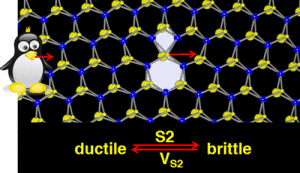Many labs have had their eye on molybdenum disulfide recently due to its promising semiconducting properties. Rice University has also turned its attention toward this 2D material and its interesting sandwich structure. During their studies, the researchers have concluded that under certain conditions, molybdenum disulfide can transform from the consistency of peanut brittle to that of taffy.
According to their research, the scientists state that when exposed to sulfur-infused gas at the right temperature and pressure, molybdenum disulfide takes on the qualities of plastic. This development has the potential to have a high impact in the world of materials science.
The structure of the molybdenum disulfide is similar to a sandwich, with layers of sulfur above and below the molybdenum atoms. When the two sheets join at different angles “defective” arrangements—or dislocations—are formed.
This from Futurity:
The researchers determined it may be possible to promote the movement of those dislocations through environmental control of the gas medium. This would change the material’s properties to give it superplasticity, which allows it to be deformed beyond its usual breaking point.
“Generally, the coupling of chemistry and mechanics is quite rare and scientifically difficult to understand,” said Boris Yakobson, theoretical physicist at Rice University. “Corrosion is the best example of how chemistry affects mechanical behavior, and the science of corrosion is still in development.”
Learn more about superplasticity in the ECS Digital Library and find out more about our publications subscriptions options!


